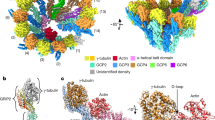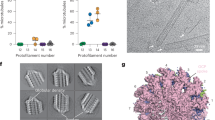Abstract
The γ-tubulin ring complex (γTuRC) is a protein complex of relative molecular mass ~2.2 × 106 that nucleates microtubules at the centrosome. Here we use electron-microscopic tomography and metal shadowing to examine the structure of isolated Drosophila γTuRCs and the ends of microtubules nucleated by γTuRCs and by centrosomes. We show that the γTuRC is a lockwasher-like structure made up of repeating subunits, topped asymmetrically with a cap. A similar capped ring is also visible at one end of microtubules grown from isolated γTuRCs and from centrosomes. Antibodies against γ-tubulin label microtubule ends, but not walls, in centrosomes. These data are consistent with a template-mediated mechanism for microtubule nucleation by the γTuRC.
This is a preview of subscription content, access via your institution
Access options
Subscribe to this journal
Receive 12 print issues and online access
$209.00 per year
only $17.42 per issue
Buy this article
- Purchase on Springer Link
- Instant access to full article PDF
Prices may be subject to local taxes which are calculated during checkout





Similar content being viewed by others
References
Moritz, M. et al. Three-dimensional structural characterization of centrosomes from early Drosophila embryos. J. Cell Biol. 130, 1149–1159 (1995).
Moritz, M., Braunfeld, M. B., Sedat, J. W., Alberts, B. M. & Agard, D. A. Microtubule nucleation by γ-tubulin-containing rings in the centrosome. Nature 378, 638 –640 (1995).
Vogel, J. M., Stearns, T., Rieder, C. L. & Palazzo, R. E. Centrosomes isolated from Spisula solidissima oocytes contain rings and an unusual stoichiometric ratio of α/β-tubulin. J. Cell Biol. 137, 193–202 (1997).
Gould, R. R. & Borisy, G. G. The pericentriolar material in Chinese hamster ovary cells nucleates microtubule formation. J. Cell. Biol. 73, 601–615 (1977).
Pereira, G. & Schiebel, E. Centrosome–microtubule nucleation . J Cell Sci 110, 295–300 (1997).
Wiese, C. & Zheng, Y. γ-Tubulin complexes and their interaction with microtubule-organizing centers. Curr. Opin. Struct. Biol. 9, 250–259 ( 1999).
Zheng, Y., Wong, M. L., Alberts, B. & Mitchison, T. A γ tubulin ring complex purified from the unfertilized egg of Xenopus laevis can nucleate microtubule assembly in vitro. Nature 378, 578–583 (1995).
Erickson, H. P. & Stoffler, D. Protofilaments and rings, two conformations of the tubulin family conserved from bacterial FtsZ to α-, β- and γ-tubulin. J. Cell Biol. 135, 5–8 (1996).
Oegema, K. et al. Characterization of two related Drosophila γ-tubulin complexes that differ in their ability to nucleate microtubules. J. Cell Biol. 144, 721–733 (1999).
Heuser, J. Protocol for 3-D visualization of molecules on mica via the quick-freeze, deep-etch technique. J. Electron Microsc. Technique 13, 244–263 (1989).
Heuser, J. Preparing biological samples for stereomicroscopy by the quick-freeze, deep-etch, rotary-replication technique. Methods Cell Biol. 22 , 97–122 (1981).
Moritz, M., Zheng, Y., Alberts, B. M. & Oegema, K. Recruitment of the γ-tubulin ring complex to Drosophila salt-stripped centrosome scaffolds. J. Cell Biol. 142, 775–786 (1998).
Erickson, H. P. Microtubule surface lattice and subunit structure and observations on reassembly . J. Cell Biol. 60, 153– 167 (1974).
Kirschner, M. W., Honig, L. S. & Williams, R. C. Quantitative electron microscopy of microtubule assembly in vitro. J. Mol. Biol. 99, 263– 276 (1975).
Detrich, H. W. D., Jordan, M. A., Wilson, L. & Williams, R. C. Mechanism of microtubule assembly. Changes in polymer structure and organization during assembly of sea urchin egg tubulin. J. Biol. Chem. 260, 9479–9490 (1985).
Simon, J. R. & Salmon, E. D. The structure of microtubule ends during the elongation and shortening phases of dynamic instability examined by negative-stain electron microscopy. J. Cell Sci. 96, 571–582 (1990).
Chretien, D., Fuller, S. D. & Karsenti, E. Structure of growing microtubule ends: two-dimensional sheets close into tubes at variable rates. J. Cell Biol. 129, 1311–1328 (1995).
Nogales, E., Wolf, S. G. & Downing, K. H. Structure of the α/β-tubulin dimer by electron crystallography. Nature 391, 199– 203 (1998).
Dubochet, J. et al. Cryo-electron microscopy of vitrified specimens. Q. Rev. Biophys. 21, 129–228 (1988).
Murphy, S. M., Urbani, L. & Stearns, T. The mammalian gamma-tubulin complex contains homologues of the yeast spindle pole body components spc97p and spc98p. J. Cell Biol. 141, 663–674 (1998).
Knop, M., Pereira, G., Geissler, S., Grein, K. & Schiebel, E. The spindle pole body component Spc97p interacts with the gamma-tubulin of Saccharomyces cerevisiae and functions in microtubule organization and spindle pole body duplication . EMBO J. 16, 1550–1564 (1997).
Knop, M. & Schiebel, E. Spc98p and Spc97p of the yeast gamma-tubulin complex mediate binding to the spindle pole body via their interaction with Spc110p. EMBO J. 16, 6985– 6995 (1997).
Tilney, L.G. et al. Microtubules: evidence for 13 protofilaments. J. Cell Biol. 59, 267–275 (1973).
Evans, L., Mitchison, T. & Kirschner, M. Influence of the centrosome on the structure of nucleated microtubules. J. Cell Biol. 100, 1185– 1191 (1985).
Pierson, G. B., Burton, P. R. & Himes, R. H. Alterations in number of protofilaments in microtubules assembled in vitro. J. Cell Biol. 76, 223–228 (1978).
Böhm, K. J., Vater, W., Fenske, H. & Unger, E. Effect of microtubule-associated proteins on the protofilament number of microtubules assembled in vitro . Biochim. Biophys. Acta 800, 119– 126 (1984).
Chretien, D., Metoz, F., Verde, F., Karsenti, E. & Wade, R. H. Lattice defects in microtubules: protofilament numbers vary within individual microtubules. J. Cell Biol. 117, 1031–1040 (1992).
Desai, A. & Mitchison, T. J. Microtubule polymerization dynamics. Annu. Rev. Cell Dev. Biol. 13, 83–117 (1997).
Byers, B., Shriver, K. & Goetsch, L. The role of spindle pole bodies and modified microtubule ends in the initiation of microtubule assembly in Sacchoromyces cerevisiae . J. Cell Sci. 30, 331– 352 (1978).
Bullitt, E., Rout, M. P., Kilmartin, J. V. & Akey, C. W. The yeast spindle pole body is assembled around a central crystal of Spc42p . Cell 89, 1077–1086 (1997).
O’Toole, E. T., Winey, M. & McIntosh, J. R. High-voltage electron tomography of spindle pole bodies and early mitotic spindles in the yeast Saccharomyces cerevisiae . Mol. Biol. Cell 10, 2017– 2031 (1999).
Kilmartin, J. V. & Goh, P. Spc110p: assembly properties and role in the connection of nuclear microtubules to the yeast spindle pole body. EMBO J. 15, 4592– 4602 (1996).
Kilmartin, J. V., Dyos, S. L., Kershaw, D. & Finch, J. T. A spacer protein in the Saccharomyces cerevisiae spindle pole body whose transcript is cell cycle-regulated. J. Cell Biol. 123,1175–1184 (1993).
Wigge, P. A. et al. Analysis of the Saccharomyces spindle pole by matrix-assisted laser desorption/ionization (MALDI) mass spectrometry. J. Cell Biol. 141, 967–977 ( 1998).
Moritz, M. & Alberts, B. M. in Methods in Cell Biology (ed. Rieder, C.L.) Vol. 61, 1–12 (Academic Press, San Diego, 1999).
Harris, J., Gerber, M., Gebauer, W., Wernicke, W. & Markl, J. Negative Stains containing trehalose: application to tubular and filamentous structures. J. Microsc. Soc. Am. 2, 43–52 (1996).
Koster, A. J., Chen, H., Sedat, J. W. & Agard, D. A. Automated microscopy for electron tomography. Ultramicroscopy 46, 207–227 (1992).
Koster, A. J. et al. Towards automatic three-dimensional imaging of large biological structures using intermediate voltage electron microscopy. Microsc. Soc. Am. Bull. 23, 176–188 (1993).
Chen, H., Clyborne, W., Sedat, J. W. & Agard, D. A. Prism: an integrated system for display and analysis of three-dimensional microscopy images. SPIE: Biomedical Image Processing and 3D Microsc. 1660, 784–790 ( 1992).
Chen, H., Sedat, J. W. & Agard, D. A. in Handbook of Biological Confocal Microscopy. (ed. Pawley, J.) 141–150 (Plenum, New York, 1990).
Acknowledgements
We thank C. Wiese and Y. Zheng for help with γTuRC preparations, H. Aldaz for suggesting the EZ-link biotin for antibody labelling, T. Keating for sharing data before publication and for advice on the manuscript, B. Keszthelyi for development of improved image reconstruction approaches, R. McQuity for improved software for automated tomography and T. Mitchison for part of M. M.’s salary. This work was supported by the Howard Hughes Medical Institute and NIH grants GM 31627 (to D.A.A.) and GM23928-22 (to T.M.).
Correspondence and requests for materials should be addressed to M.M.
Author information
Authors and Affiliations
Corresponding author
Rights and permissions
About this article
Cite this article
Moritz, M., Braunfeld, M., Guénebaut, V. et al. Structure of the γ-tubulin ring complex: a template for microtubule nucleation. Nat Cell Biol 2, 365–370 (2000). https://doi.org/10.1038/35014058
Received:
Revised:
Accepted:
Published:
Issue Date:
DOI: https://doi.org/10.1038/35014058
This article is cited by
-
Microtubule nucleation and γTuRC centrosome localization in interphase cells require ch-TOG
Nature Communications (2023)
-
Centrosome: A Microtubule Nucleating Cellular Machinery
Journal of the Indian Institute of Science (2021)
-
Einblicke in die Entstehung von Mikrotubuli
BIOspektrum (2020)
-
XMAP215 is a microtubule nucleation factor that functions synergistically with the γ-tubulin ring complex
Nature Cell Biology (2018)
-
The catalytic subunit of DNA polymerase δ inhibits γTuRC activity and regulates Golgi-derived microtubules
Nature Communications (2017)



